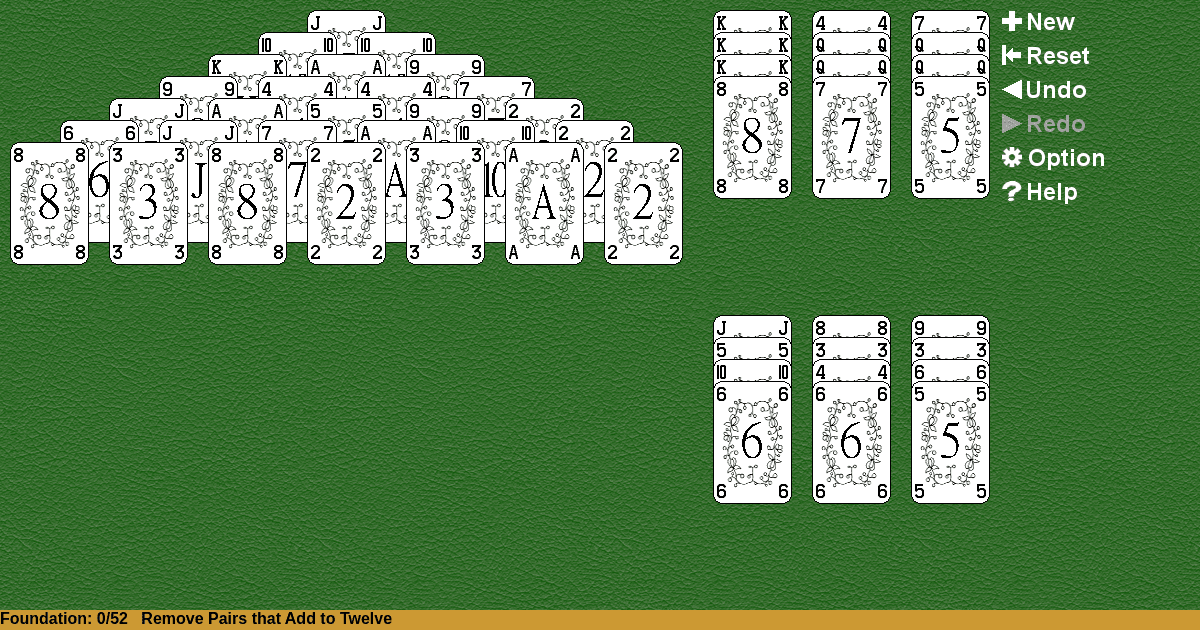Pyramid Dozen
Home |
How to play |
FAQ |
About
How to play Pyramid Dozen?
Game Objective:
The objective of Pyramid Dozen Solitaire is to remove all cards from the tableau by pairing cards whose values sum to twelve (a "dozen"). The game is won when no cards remain in the tableau and all pairs have been correctly removed.
Setup & Layout:
- Deck: Uses a standard 52-card deck.
- Tableau (Pyramid):
- Construct a pyramid of 28 cards:
- Row 1: 1 card (top)
- Row 2: 2 cards (overlapping the previous row)
- Row 3: 3 cards
- Continue this pattern until Row 7, which has 7 cards.
- All cards in the pyramid are dealt face-up and overlap so that only cards not covered by others are available for play.
- Stock: The remaining 24 cards form the stock pile, placed face-down beside the pyramid.
- Waste/Discard Pile: As cards are drawn from the stock, they are placed face-up in a waste pile.
- Foundation: Removed pairs are placed in a foundation pile (not reused in play).
Key Play Areas:
- Tableau: The pyramid of 28 face-up cards.
- Stock: Face-down pile for drawing new cards.
- Waste: Face-up pile for cards drawn from the stock.
- Foundation: Area for removed pairs.
Pyramid Dozen Solitaire Rules:
- Card Values:
- Ace = 1, 2–10 = face value, Jack = 11, Queen = 12, King = 13.
- Pairing Rule:
- Pairs of cards must sum to exactly 12 to be removed from play.
- Example pairs: Ace (1) + Jack (11), 2 + 10, 3 + 9, 4 + 8, 5 + 7, 6 + 6, Queen (12) alone.
- Available Cards:
- Only uncovered cards (not overlapped by others) in the pyramid are available for pairing.
- The top card of the waste pile is also available for pairing with any uncovered tableau card.
- Building Sequences:
- There is no building of sequences by suit or color; the only rule is pairing to twelve.
- Card Movement:
- Cards are removed in pairs that sum to twelve.
- A Queen (12) is removed on its own, as it equals the target sum.
- No more than two cards may be removed at a time.
Gameplay:
- Turn Sequence:
- Search for pairs among uncovered tableau cards that sum to twelve and remove them.
- Pair the top waste card with any uncovered tableau card if they sum to twelve.
- If no pairs are available, draw one card from the stock and place it face-up on the waste pile.
- Repeat the process: always check for available pairs before drawing from the stock.
- Stock Reuse:
- When the stock is depleted, the waste pile may be turned face-down to become the new stock.
- The number of times the stock can be recycled is set at the start (commonly three times or unlimited).
- No Moves Available:
- If no legal pairs can be made and the stock is exhausted (with no permitted recycles), the game ends.
Winning & Losing Conditions:
- Win:
- All cards have been removed from the tableau by valid pairs (and single Queens).
- Lose:
- No more legal moves can be made, and cards remain in the tableau.
- The stock is exhausted and cannot be recycled further (if a recycle limit is set).
Special Rules & Edge Cases:
- Empty Spaces:
- Once a card is removed from the pyramid, it simply exposes the cards beneath; empty spaces are not filled.
- Unpairable Cards:
- If a card (e.g., an Ace) is blocked by cards that cannot be paired with it (e.g., all Jacks are buried), it may become impossible to win.
- Stock Recycle:
- The number of permitted stock recycles is determined at the start (three or unlimited).
- No Suit or Color Restrictions:
- Pairing is based solely on card values summing to twelve; suits and colors are ignored.
- Queen Removal:
- A Queen (value 12) is removed from play on its own without pairing.
- No Filling of Tableau:
- Once a tableau pile is empty, it remains empty and cannot be filled with other cards.
Note: The above rules are specific to Pyramid Dozen Solitaire, which differs from classic Pyramid Solitaire by requiring pairs to sum to twelve instead of thirteen, and by allowing single Queens to be removed.

Solitaire Collection
About Pyramid Dozen
Rate (Pyramid Dozen)
4.7 / 5
1,916 votes



























































